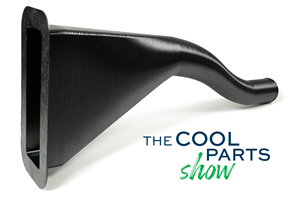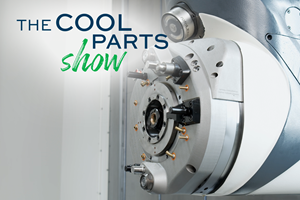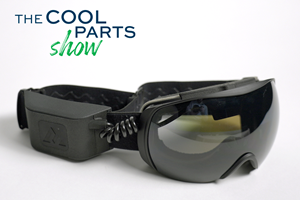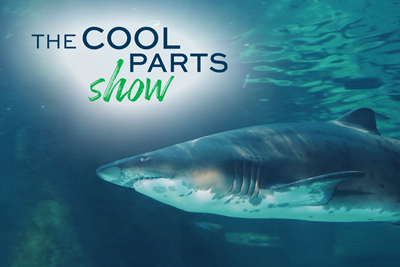The Drone Bird Company has developed a line of drones that mimic birds of prey like falcons in both outward appearance and flight pattern. These drone birds can be purchased or hired as a service to scare away real birds from airports, farms, power plants and other settings where their presence could be a nuisance or a hazard. The fuselages for these drones were initially produced through hand layup of glass fiber and epoxy which was time-consuming and not scalable. The Drone Bird Company worked with Parts on Demand to move into production through selective laser sintering (SLS) 3D printing, ultimately adopting a glass sphere-filled polymer from Advanced Laser Materials (ALM) to achieve lightweight, durable drone bodies that can be made repeatably at scale.| This episode of The Cool Parts Show is sponsored by Carpenter Additive
The Cool Parts Show is a video series from Additive Manufacturing Media that explores the what, how and why of unusual 3D printed parts. Watch more here.
Have a cool part to share? Email us.
Related Resources
- The Drone Bird Company
- Parts on Demand, contract manufacturer for 3D printed components of this drone
- Advanced Laser Materials (ALM), the EOS subsidiary that supplies the glass-filled material
- Another example of a drone that relies on 3D printing, in this case both metal and polymer
- Other examples where 3D printing makes use of biomimicry of shark scales, butterfly wings, and snail shells
Transcript
Introduction
00:00:00:00 - 00:00:00:23
Pete Zelinski
I’m Pete.
00:00:00:23 - 00:00:06:20
Stephanie Hendrixson
I'm Stephanie and this is The Cool Parts Show, our show all about cool, interesting, innovative 3D printed parts.
00:00:06:20 - 00:00:15:06
Pete Zelinski
This drone looks even moves like a bird of prey, so much so that its inventor built a business out of scaring birds.
00:00:15:06 - 00:00:20:14
Stephanie Hendrixson
The company is now scaling up, using 3D printing for some key components of this drone.
00:00:20:14 - 00:00:24:06
Pete Zelinski
The drone bird on this episode of The Cool Parts Show.
00:00:29:03 - 00:00:39:16
Pete Zelinski
The Cool Parts Shows brought to you by Carpenter Additive. When it comes to managing metal powder, there is no one size fits all approach. Stick around after the episode to learn more.
00:00:40:02 - 00:00:41:13
Pete Zelinski
Welcome to The Cool Parts Show.
00:00:41:13 - 00:01:00:03
Stephanie Hendrixson
If you like the show, make sure to subscribe on YouTube to get notified about our new episodes. And as a reminder, you can also sign up for our All Access newsletter to get notified about new content before it appears publicly here. On this episode of the show, we're going to be learning all about this drone that looks like, flies like a peregrine falcon.
Biomimicry
00:01:00:03 - 00:01:26:02
Pete Zelinski
Yeah, manufacturing drones is an important application of 3D printing. Remote aircraft are made that way and this drone leverages some of the advantages that 3D printing brings to other drones. Advantages like assembly consolidation, lightweighting. But then there are other 3D printing benefits that apply to this drone in particular, notably biomimicry.
00:01:26:02 - 00:01:51:07
Stephanie Hendrixson
But this is biomimicry in sort of a different way than we usually associate it with additive manufacturing. Like we've seen these crazy topology optimized structures that look like they come from plants or from cell structures or for something else in nature. But this is sort of biomimicry on a macro scale. The entire drone looks like a peregrine falcon. It uses its wings, it flaps its wings to fly, and it doesn't look exactly like a raptor when it moves, but it looks close enough.
00:01:51:07 - 00:02:20:23
Pete Zelinski
All of that is valuable because of the function this drone performs. It scares away real birds, scares them away from situations, settings where they could be a danger or a problem like airports or industrial facilities or power plants or agriculture. The drone bird company engineered a solution to that problem, and the aim of biomimicry in this case is for that purpose, being scary.
00:02:20:23 - 00:02:41:22
Stephanie Hendrixson
But this was sort of an accidental discovery. This product, this company comes out of research to develop a bird like drone. And the added benefit of scaring away problem birds was something that they sort of discovered along the way. So let me introduce you to Jan-Willem van den Eijkel. He is the CEO of the Drone Bird Company. Also goes by J.W.
00:02:41:22 - 00:03:57:17
Jan-Willem (JW) van den Eijkel
This company started about eight years ago, and basically it was established by a student who was doing a master's thesis on making robotic flying birds. Basically why it works. Birds see the robot, which is mimicking a peregrine Falcon actually is a real peregrine falcon. And 85% of the birds species in this world are very afraid of the peregrine falcon. Birds are very clever, very intelligent. They get used to and habituate to all kinds of means, like lasers or gas cannons, but you don't see any habituating with the falcon. And this because this fear is so deeply tied in their DNA and the instincts that even one day, chickens when they hatch out of the eggs, they already show a response to peregrine falcons. And the other thing is, when I take you as an example, and I would drive a truck towards you at a high speed. You will step aside every day again, even if I do it daily. So that's the other factor, if something is coming towards you with great speed and that's combined with the mimicking of a peregrine falcon, gives this great effect
00:03:57:17 - 00:04:14:13
Pete Zelinski
So that master's thesis on robotic birds connected to a valuable industrial application. A company was formed and that company then needed a way to produce more of these drones, manufacture them effectively.
Drone Bird Specifications
00:04:14:13 - 00:04:28:13
Stephanie Hendrixson
And there's a lot that goes into one of these drones. So you have the tail, the wings, this body that they call the fuselage on the outside, that all has to look like a bird. But then inside you have all of the motors and the electronics and everything else that you need to make this work
00:04:28:13 - 00:04:55:07
Jan-Willem (JW) van den Eijkel
There's a lot of software next to the mechanical things going on and next to the materials in order to actually build these birds. It all starts by basically making it fly stable and fly like an actual bird. And I think the most complex thing was getting the mechanics right and getting the wing profile, together with, of course, the use of materials and getting the weight right. We are talking about making one kilo fly like actual birds with flapping wings.
00:04:55:07 - 00:05:18:18
Stephanie Hendrixson
So making one kilogram of equipment fly as if it's a bird is challenging enough. But there are some other considerations that have influenced manufacturing decisions around these drones. So for one thing, the drone is battery powered, so you want it to be really lightweight. The lighter the weight, the longer the battery life, the more you can fly the drone and the more effective it can be. Secondly, it needs to be very durable.
Initial Materials
00:05:18:18 - 00:05:39:04
Stephanie Hendrixson
You might notice that “Gertie” here doesn't have any sort of landing gear, so she needs to be able to withstand a potential crash landing. And so the need to achieve a lightweight and durable drone led the Drone Bird Company not to additive manufacturing originally, but actually to composites, to a hand layup process for some of these parts.
00:05:39:04 - 00:05:57:13
Jan-Willem (JW) van den Eijkel
Basically manual labor with glass and epoxy. So you create a mold and from this mold you basically make layers with glass and epoxy to get to the actual shape, but it's very time consuming and it's also very tedious work doing this manual labor.
Scaling Up Production with SLS
00:05:57:13 - 00:06:21:13
Pete Zelinski
Manual labor. They wanted to get away from that in producing components that are lightweight, durable, complex shaped, organic shaped. 3D printing was a natural fit, and The Drone Bird Company saw that from the beginning. They were using 3D printing already to make prototypes, But scaling up into production with 3D printing was a different matter.
00:06:21:13 - 00:06:33:02
Stephanie Hendrixson
So they worked with this company called Parts on Demand, to move into production through 3D printing. This is Neil Van Es. He is the CEO of Parts on Demand.
00:06:33:02 - 00:07:03:08
Neil Van Es
I got involved with the drone bird project I think it was like five years ago because Jan-Willem reached out. Before they were producing the drone bird through a conventional method, so I think it was like glass fiber molding. And they did some first prototypes with 3D printing with one of the FDM printers and were searching for a partner to basically give them more freedom of design, a more industrial way of 3D printing and a better quality of product
00:07:03:08 - 00:07:19:06
Pete Zelinski
That more industrial mode of 3D printing that Parts on Demand turned to was selective laser sintering on a machine from EOS. Selective laser sintering, powder based process. Polymer in a powder form is fused together to make the part.
00:07:19:08 - 00:07:36:06
Pete Zelinski
The material is important. We'll get to that in a minute, but selective laser sintering, SLS, allowed these parts to be made not just repeatedly, but also many pieces at a time, all in a single 3D printing build.
00:07:36:06 - 00:08:10:16
Neil Van Es
The workflow typically is that we don't produce a single part, but we produce in batches of parts. We basically have a cubic volume that we fill with many parts that need to be produced in the same batch just as a giant Tetris puzzle. The entire batch is sliced into layers and the layers are sent to the printer, and the printer manufactures that by laying down a layer of powder, heating it just below the melting point, and then selectively fusing the cross sections of the parts with the laser.
Final Material Selection
00:08:13:05 - 00:08:42:16
Stephanie Hendrixson
So compared to that manual composites layup process SLS is a lot more automated, it's more repeatable. It allows you to make lots of bird bodies at once if you need to. But as Parts on Demand got into this work, they started to wonder if they were using the best possible material. They do a lot of printing with PA12 nylon and that's sort of what they started out with. But they started to wonder if they could reduce the weight of these drones even further while still maintaining the durability and strength by switching to a different, more specialized material.
00:08:42:16 - 00:09:00:08
Stephanie Hendrixson
So for that they turned to ALM Advanced Laser Materials, which develops powders for additive manufacturing. ALM is also a fully owned subsidiary of EOS, which also supplies that sales equipment that Parts On Demand uses. Here is Sam Houston. He's a senior manager at ALM Global.
00:09:00:08 - 00:09:31:17
Sam Houston
The material that's used in the bird drone in this case is a material called the PA640 GSL, and it's a material with a Nylon 12 with both carbon fiber and hollow glass. So it provides extra strength, a very nice surface finish all while being very lightweight. So the 640 GSL is interesting in the sense that it is a nylon 12 but the combination of carbon fiber and hollow glass beads give it some significant benefits over just maybe a standard nylon 12. It's also very easy to process like a nylon 12. It's got good thermal stability, continuous use at around 150 degrees C. It’s so light that it will actually float on water.
00:09:45:19 - 00:09:57:22
Sam Houston
Also the benefits of it’s lightweight, it's part density is 0.2 grams per cubic centimeter, so that's even less than something like a standard nylon 12.
00:09:57:22 - 00:10:32:23
Sam Houston
It's a good material for applications that require strength and weight ratio. And in this particular case, with the drone bird, those were the two most important requirements is strength and weight. So the material needs to be strong enough for all the hazards of flight, which might include, like, I don't know, something like the hidden power lines or an occasional tree limb while soaring through the air. And then for the weight side of things, you want it to be as light as possible because that's going to allow the battery to last longer and allow the bird drone to have longer flight time and even faster if needed.
00:10:32:23 - 00:11:22:01
Pete Zelinski
So The Drone Bird Company, its manufacturing partner Parts on Demand it's material supplier ALM. So they've got the process, they've got the material. Next up is optimizing the design. The purpose of this drone is simple, scaring birds, but the design considerations for getting to that are pretty numerous. There's a lot going on here. There are electronics that have to be mounted securely inside the body of this drone. It has to do that within components that ought to be easy to assemble and the whole thing has to be lightweight. And in fact, lightweighting proved to be a major consideration. So the team set about making this drone as lightweight as possible.
00:11:22:01 - 00:12:01:23
Neil Van Es
With 3d printing we can do a lot of function integration. So a lot of the parts that needed to be assembled, like the mounts, we could now print into the actual fuselage of the drone bird. And these drones are all about saving weight. We were working towards the absolute minimum of wall thicknesses to reduce every single gram of weight we could find. With all the functionality of the mounts in there, so the guys at Jan-Willem’s only needed to install like the little things like motors, batteries, cabling and the rest would be a self-contained unit.
00:12:01:23 - 00:12:22:22
Jan-Willem (JW) van den Eijkel
In the internals of the body we mount all kinds of electronics like flight controller but also to the surface to control the tail. And all these mounts basically are already preprinted in the body. So we just have to screw it down the electronics, which you want to fit. And this is all being taken care of by the printer for us.
00:12:22:22 - 00:12:39:01
Stephanie Hendrixson
So the drone birds have been through this whole evolution from hand layup to SLS 3D printing from PA12 nylon to this new glass filled material and from this very tedious assembly process to something that's much more streamlined by virtue of these 3D printed parts.
00:12:39:01 - 00:13:16:01
Pete Zelinski
Production of the drone bird is underway. J.W. didn't necessarily expect that, his business was initially a service, but there's so much demand for that service for the work that this drone can do, that mass producing these drones to sell to users has proved to be the next step. Parts on Demand is helping with initial rate production and also helping with the introduction of new design options. Like this. This is a variant on the drone bird. This is a fixed wing design. Instead of this version that flaps its wings.
00:13:16:07 - 00:14:14:21
Jan-Willem (JW) van den Eijkel
At first we start out as a service especially the robotic flapping falcon, because it was at that time still very complex, a lot of maintenance etc. Now after the enhancements it is ready to sell. We have sold now a few of them but mainly we are now focusing and because it's much cheaper for us to produce and much cheaper for the client. We also sell the fixed wing peregrine falcons because we have seen, although they are maybe less sexy because they are not propelled with flapping wings but by a prop in the nose. But the effect on the birds is actually the same. We are daily optimizing and developing our birds, on the flapping birds like the peregrine falcon, also the fixed wing birds and our latest project basically are going out to more unobtrusive surveillance birds for police, special forces. Think of large birds with two-meter span which we can equip camera.
00:14:14:21 - 00:14:16:11
Stephanie Hendrixson
All right. I think we got this.
00:14:16:11 - 00:14:30:15
Pete Zelinski
Okay, This is the drone bird. Remote aircraft that looks like a bird of prey. Looks like a peregrine falcon. Its purpose is to scare real birds, and 3D printing allowed this drone to go into production.
00:14:30:20 - 00:14:55:14
Stephanie Hendrixson
The drone bird company developed this product initially with a fuselage made through hand layup. They worked with parts on demand to transition the body and some other parts on the drone to SLS 3D printing. ALM provided the glass filled material that provides the lightweighting and the durability that's needed. And they're now working on new variations of this drone as well, including fixed wing models.
00:14:55:14 - 00:15:29:21
Pete Zelinski
When we were researching this episode, we learned something more. Parts on Demand is located in the Netherlands, major food exporter. Neil, who you heard from in this episode, had a lot to say about 3D printed automation for the food industry. It's really interesting. You should watch. Our All Access subscribers got to see that. And you can see it too. Signing up is really easy. You'll get advance notice whenever a new episode appears and extra segments just for subscribers, it's free. TheCoolPartsShow.com/AllAccess.
00:15:29:21 - 00:15:39:21
Stephanie Hendrixson
And if you have a cool part, something that takes advantage of biomimicry, something that uses a new or unique material, we’d love to hear about it. Please email us CoolParts@AdditiveManufacturing.media.
00:15:40:17 - 00:15:42:09
Pete Zelinski
Thank you for watching.
00:15:42:09 - 00:16:05:20
Pete Zelinski
This episode is brought to you by Carpenter Additive. We're past the point of not knowing how to qualify metal 3D printed parts. We know, it's just that different end users of those parts have different qualification requirements. Additive manufacturing service providers have to navigate that. And Carpenter Additive has to think about that in tailoring powder management solutions.
00:16:05:20 - 00:16:34:16
William Herbert
Our customers typically will have, if they are a service provider, they will have a series of end user customers who may be say OEMs in the aerospace world, and each of them has a fairly large team of engineers who've been doing this for decades or more and have developed all these standards, regulations, paperwork. So it is certainly a challenge to thread the needle between all of these different requirements
00:16:35:01 - 00:17:22:10
William Herbert
We start really high level. We walk on the shop floor, we ask them about their source to sink, How do you bring in the materials goods in, send that material to each of the systems. And then what we're really interested in is how do they reuse that material? So what we do is called the value stream map.
Pretty often that leads to a series of things that were either overlooked or hadn't really boiled up to the surface yet in terms of things that are potential risks or potential challenges or inefficiencies that exist. A lot of the customers we work with, especially in the more regulated industries such as space or medical or aerospace, have already been through those early learning stages. They've put five plus years into this. They've done the product design and the design for additive manufacturing.
00:17:22:10 - 00:17:33:22
William Herbert
And now they're starting to reach some of the more finicky problems that you get when you're at the scale of maybe five, ten machines. You're running different materials simultaneously, you're doing different programs.
00:17:33:22 - 00:17:49:23
William Herbert
We get to take the best from the medical field and the aerospace field. We understand the specifications and the standards that exist in each of those fields, and we can sort of take the best elements of those and customize that to our customers.
Related Content
3D Printed Metal Filters Protect Circuit Breakers from Explosion: The Cool Parts Show #57
New high-voltage circuit breakers from Schneider Electric make use of 3D printed metal filters to protect people and equipment in the event of an overload. Binder jetting provided both the geometric complexity and price point needed for these parts.
Read MoreAircraft Ducts 3D Printed in Composite Instead of Metal: The Cool Parts Show #68
Eaton’s new reinforced PEKK, tailored to aircraft applications, provides a cheaper and faster way to make ducts compared to formed aluminum.
Read More3D Printed Metal Component for CNC Machining Center: The Cool Parts Show #47
Machine tool maker DMG MORI improved this coolant delivery adapter by making the part through additive manufacturing instead of machining. One of the viewer-chosen winners of The Cool Parts Showcase.
Read MoreRekkie AR Ski Goggles Made Possible With 3D Printing: The Cool Parts Show #53
When the electronics enclosure key to these AR goggles proved difficult to mold, 3D printing allowed the inventors to keep the complexity — while also making improvements for assembly and user experience.
Read MoreRead Next
It's Shark Week on The Cool Parts Show
In this bonus episode, we dive into biomimicry and discuss how shark denticles are being used for research as well as Cool Parts.
Read MoreDrones Take Flight with Metal and Polymer 3D Printed Parts: The Cool Parts Show Bonus
Drones produced by Cobra Aero now incorporate many 3D printed parts made through laser powder bed fusion and Multi Jet Fusion processes.
Read More3D Printed Heat Exchanger Uses Gyroids for Better Cooling | The Cool Parts Show #43
Replacement heat exchanger for a helicopter is half the size and delivers 4× the cooling, thanks to a geometry that could only be made via additive manufacturing.
Read More

.jpg;width=70;height=70;mode=crop)













